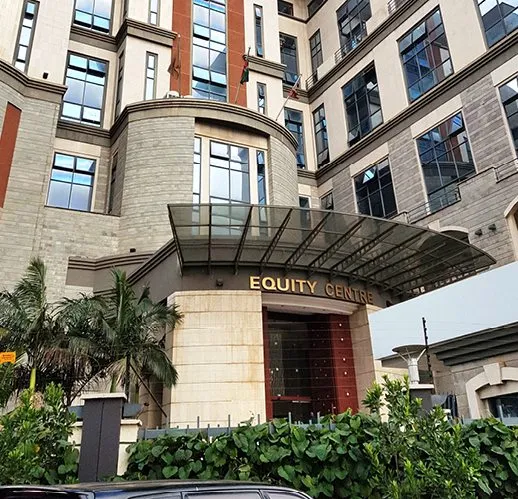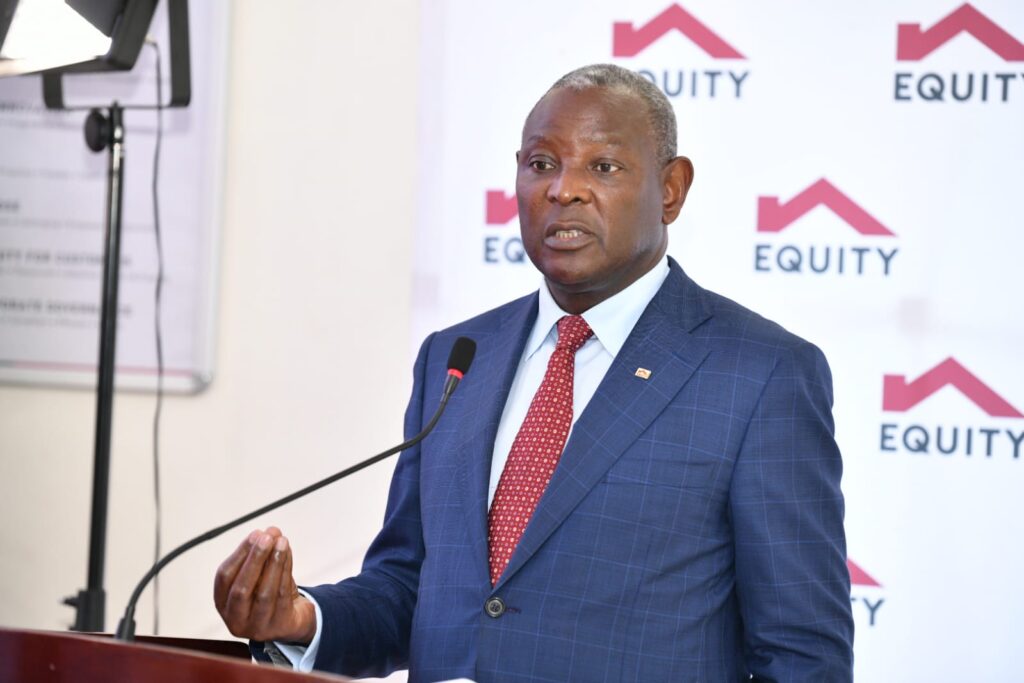
From left to right: EquityBCDC Managing Director, Celestin Muntuabu, Equity Life Assurance (Kenya) Limited Managing Director, Angela Okinda, Equity Group Managing Director and CEO, Dr. James Mwangi, Equity Bank Tanzania Managing Director, Isabella Maganga and Equity Bank Kenya Managing Director, Gerald Warui during the Q3 2023 Investor Briefing event. Equity Group registered a 26% growth in loan book to Kshs.845.9 billion up from Kshs. 673.9 billion, to support customers in a difficult macro-economic environment resulting in a profit after tax growth of 5% to Kshs. 36.2 billion up from Kshs. 34.4 billion with Kenya contributing 50% of the net profit and subsidiaries contributing a further 50%. The Group registered an interest income growth of 32% to Kshs. 111.1 billion up from Kshs. 84.2 and an interest expense growth of 58% to Kshs. 38.5 billion up from Kshs. 24.4 billion.
Equity Group Holdings chose Customers Over Profits;
- Grew loan book by 26% to support customers in a difficult environment.
- Maintained yields on loan almost flat at 12.1% despite 35% growth in cost of funding.
- Interest income growth of 32% trails interest expense growth of 58% as the Group opted to absorb the cost increase instead of passing it over to the customers.
- Group intensifies financial literacy and entrepreneurship training, strengthens relationship management, and applies Kshs.21.4 billion credit guarantees to capacitate and de-risk customers.
The Group chose to moderate the inflation impact, by absorbing the effect of inflation in its operational cost, while at the same time absorbing the rise in interest rate on deposit/debt without transferring the full effect to the customers.
In a macro-economic environment characterized by high inflation, interest rates and a strengthened US Dollar against local currencies that has hit the economies and the customers hard, Equity Group Holdings (‘the Group’) chose to stand by and cushion its customers while keeping on the lights of the economies it operates in.
The Group grew its loan book by 26% from Kshs. 673.9 billion to Kshs.845.9 billion allowing the lights of the economies to remain on, while offering its customers the funding flexibility to restructure their businesses and adopt to the new normal while taking advantage of new green shoots as the economic reforms create new opportunities.

Picking the lessons and insights from the Covid-19 global health pandemic when the Group saved thousands of households, micro, small and medium enterprises by giving them loan repayment breaks and rescheduling 45% of its loan book, the Group determined that the macro-economic shocks occasioned by rise in interest rate, inflation and depreciation of local currencies required transferring and mitigating from transmission of the entire impact on households and enterprises.
While interest expense on funding from deposits and long-term debt grew by 58% as a result of the high cost of funding driven by the current economic environment, top line interest income grew by 32%, with net interest income growing by 21% as the Group chose to cushion its customers by not passing the entire cost of funding over to them. Speaking while releasing the results during the Group’s 3rd Quarter 2023 investor briefing, Dr. James Mwangi, Equity Group Managing Director and CEO said, “It was a strategic decision to support and cushion our customers to fortify their opportunities for survival and enhance their resilience during these difficult economic times by absorbing part of the funding costs and keeping yields on loans and government securities at almost the same level at 12.1% and 11.5% respectively”.
 “We grew our loan book by 26% despite the uncertainty of difficult economic times to ensure our customers continued to fund their dreams while keeping the lights of the economy on.
“We grew our loan book by 26% despite the uncertainty of difficult economic times to ensure our customers continued to fund their dreams while keeping the lights of the economy on.
We did not hesitate in making this strategic decision to focus on supporting our customers to navigate and survive the difficult and challenging microeconomic environment as this aligns to our true north, our purpose to change lives, give dignity and expand opportunities for wealth creation. It was an easy strategic choice to focus on the long-term resilience of our customers’ success,” added Dr. Mwangi.
As a result of interest expense growing faster at 58% than interest income that grew by 32%, net interest income grew slower at 21%, while non-funded income grew at 38% to deliver a 28% growth in total income. Total costs grew by 47% as the Group opted to absorb the impact of global and regional inflation and depreciation of local currencies that saw staff expenses grow by 33% and other operating expenses by 38%.
While the cost of funding and deposits rose by 35% and total operating costs grew by 47%, yields on loans increased by 7% only from 11.3% to 12.1% as we focused on cushioning customers to enhance their chances of survival and resilience. Loan loss provision grew by 107% from Kshs. 8.6 billion to Kshs. 17.7 billion to strengthen the NPL provisions coverage buffers. Consequently, profit after tax grew by 5% to Kshs. 36.2 billion up from Kshs. 34.4 billion.
The long-term strategic pursuit of geographical expansion and diversification continues to deliver impressive results. Group deposits grew by 20% to Kshs. 1,208.6 billion up from Kshs. 1,007.3 billion with Kenya contributing 51% after a growth of 4% while subsidiaries contributed a 49% growth driven by deposit growth of 28% in DRC, 32% in Uganda, 39% in Rwanda and 56% in Tanzania.

Loans grew by 26% to Kshs.845.9 billion up from Kshs.673.9 billion with Kenya contributing 54% after a growth of 8% while subsidiaries contributed a 46% growth reflecting strong growth of 71% in DRC, 40% in Uganda, 33% in Tanzania and 20% in Rwanda.
Total assets grew by 24% to Kshs.1,691.2 billion up from Kshs.1,363.7 billion with Kenya contributing 53% after a growth of 11% and subsidiaries contributing 47% driven by 31% growth in DRC, 34% growth in Uganda, 40% growth in Rwanda, 44% growth in Tanzania and a 63% growth by Equity Life Assurance Kenya.

Group revenue registered a 28% growth with Kenya contributing 50% after a 13% growth as subsidiaries contributed 50% driven by strong revenue growth of 81% in DRC, 33% in Uganda, 38% in Rwanda and 203% for Equity Life Assurance Kenya. Non-funded income registered robust growth of 38% to Kshs. 56.5 billion up from Kshs. 41.1 billion as net interest income grew by 21% to Kshs. 72.6 billion up from Kshs. 59.8 billion allowing non-funded income to contribute 43.8% of the total income of Kshs.129.1 billion up from 40.7% the previous year.
Group profit after tax grew by 5% to Kshs. 36.2 billion up from Kshs. 34.4 billion with Kenya contributing 50% with an equivalent contribution of 50% coming from the subsidiaries driven by a growth of 142% in DRC, 23% in Uganda, 46% in Rwanda, 136% in Tanzania and 177% by Equity Life Assurance Kenya.
A Group-wide broader strategic diversification by geography, business lines, industry/sector, product portfolio, currencies of operations, streams of income and delivery mechanism has yielded risk management benefits and strengthened the Group’s resilience by sustaining key buffers of diversified quality income streams, capital base, liquidity and quality of assets and efficient and effective operational delivery mechanisms.
| KENYA | SUBSIDIARIES | |
| Total Assets | 53% | 47% |
| Revenue | 50% | 50% |
| Profit after tax | 50% | 50% |
The loan book reflects diversification with 47.6% being in US dollars while 52.4% is in local currencies. It is distributed among retail, MSME, agriculture, corporate and large enterprises, and public sector covering all segments of the economy and eco-systems.Branches processed 5% of the loan disbursements with a value of 58% of the entire portfolio while digital channels processed 95% of loan disbursements and 42% in value. Innovation and business transformation through digitization in lending and lifestyle support, digital and online transaction processing, and payments have delivered ease and convenience to customers.
| Disbursement Value Growth | Disbursement transaction count growth | |
| Kenya | 55% | 55% |
| Uganda | 144% | 115% |
| Tanzania | 2,088% | 117% |
Digitization continues to register good adoption with 82% of all transactions now being cashless.
Through diversification of operations, the Group has anchored a high-quality diversified streams of income that are resilient to shocks resulting in 28% growth in total income.
| STREAM OF INCOME | CONTRIBUTION | PERCENTAGE CONTRIBUTION
|
| Interest income on Loan & Advances | 70.6 billion | 44.8% |
| Interest income on Government Securities | 36.5 billion | 23.2% |
| Fees & Commission on Loans and Advances | 6.8 billion | 4.3% |
| Transaction fees, Trade Finance
& Non-loan commissions |
29.7 billion | 18.9% |
| Foreign Exchange Trading | 13.9 billion | 8.8% |
Focus on Trade Finance in support of the Africa Continental Free Trade Agreement (AfCFTA) aspirations, saw gross trade finance income grow by 90%. Foreign exchange income grew by 56% which was driven by a 24% growth in foreign remittances to Kshs. 309.1 billion up from Kshs. 248.7 billion delivering essential forex inflows while raising remittance processing income by 19% from Kshs.1.3 billion to Kshs1.6 billion.
A difficult macroeconomic operating environment characterized by high inflation and interest rates and depreciation of local currencies as the US Dollar strengthened saw NPLs increase to 12.2% up from 9.8% against an industry average NPL of 15% as at August 2023.
To mitigate the effects of the NPL rise, the Group increased loan loss provisions by 107% to Kshs.. 17.7 billion up from Kshs.. 8.6 billion to achieve a strong NPL coverage of 67.2% on provisions and 86.4% with guarantees at an elevated cost of risk of 3.2% up from 2.0%.
High inflation and depreciation of local currencies saw staff cost growth of 33% while other operating costs grew by 38% resulting in total cost growth of 47% faster than 28% growth in total income. This drove the cost income ratio to 50.2% up from 41.7% resulting in a 5% growth in net income or profits after tax to Kshs. 36.2 billion, up from Kshs. 34.4 billion.
The Group strategically positioned the balance sheet to be agile with a liquidity ratio of 49.7% to respond to emerging opportunities as the macroeconomic environment eases and to have a quality balance sheet as uncertainty reduces and business bounces back.
AN AGILE BALANCE SHEET
| ASSETS
|
KSHS BILLIONS | PERCENTAGE CONTRIBUTION | FUNDING | KSHS BILLIONS | PERCENTAGE CONTRIBUTION
|
| Cash & Cash Equivalent | 262.7 | 15.6% | Deposits | 1,208.6 | 71.5% |
| Government Securities | 445.2 | 26.3% | Long-term funds/debt | 214.0 | 12.6% |
| Net Loans | 845.9 | 50.0% | Shareholders’ funds | 195.2 | 11.4% |
The agility of the balance sheet combined with loan portfolio diversification geographically and across broad sectors and segments and a diversified bucket of currencies offer the Group the flexibility of repositioning with emerging opportunities to pursue growth as the economic tide turns. In spite of the challenging macroeconomic environment, the Group has preserved and sustained its strength in asset quality relative to the market at 12.2%, high liquidity of 49.7%, strong NPL coverage of 67.2%, and an agile balance sheet supported by strong capital buffers with the core capital to risk weighted assets at 15.2% against a minimum of 10.5% and total capital to total risk weighted assets of 19.2% against a minimum legal requirement of 14.5%, giving the Group headroom for agility and flexibility as the macroeconomic environment eases.
Equity Group has intensified its social impact investments through its shared prosperity model to capacitate and de-risk clients through financial education for women and youth which has benefited 2,422,030 clients, with 459,537 MSMEs receiving financial training to strengthen their entrepreneurship skills. Kshs. 259.3 billion has been disbursed to 269,081 MSMEs under the `Young Africa Works Program’ in partnership with Mastercard Foundation, also availing a credit guarantee and credit risk sharing facility within the program.3.8 million small-scale farmers have been served via capacity building and access to finance programs that have, in addition, reached 292,362 small and medium sized agri-businesses.
The Group has also supported community and society through its Wings to Fly and Elimu Scholarships which have benefited 55,583 secondary school scholars, while the Equity Leadership University Program has reached, 18,735 university scholars with 857 global scholars and 3,454 full scholarships for TVET programs. The Equity Afia Medical Franchise with 89 medical facilities has recorded 1,921,919 cumulative patients visits.
The Group continues to grow its brand, now recognized as the 4th strongest financial brand globally by Brand Finance while registering superior performance to be ranked in the 14th position of Africa’s best performing banks and the best and strongest in Eastern and Central Africa by The Africa Report.
In this challenging macro-economic environment, the Group has registered a Return on Average Assets of 3.1% and a Return on Average Equity of 25.1%, while being strategically positioned with strong capital and liquidity buffers to bounce back as the stormy macroeconomic tide eases and as the operating environment improves with the recovery of our economies.









